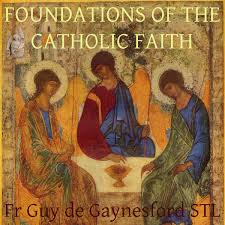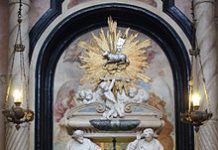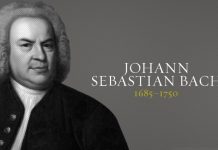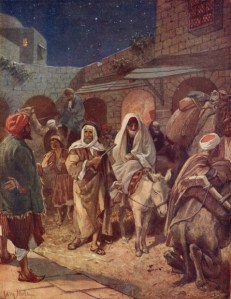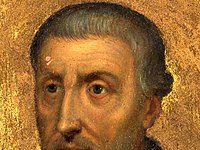(On what would be the feast of Saint Nicholas, the great foe of heretics, you may enjoy this delightful reflection from Father Callam on the ‘hierarchy of truths’, a much misunderstood truth – but one which Bishop Nicholas would have grasped, as he grasped the beard of the heretic Arius, Council of Nicaea. Editor)
“The hierarchy of truths” is a phrase found in the Decree on Ecumenism (Unitatis Redintegratio) of Vatican II where the Council is advising Catholic theologians engaged in ecumenical dialogue: “When comparing doctrines with one another, they should remember that in Catholic doctrine there exists an order or ‘hierarchy’ of truths, since they vary in their relation to the foundation of the Christian Faith.”[1] Edward Yarnold, S.J., in an article “Mary and the Work of ARCIC”[2] deprecates an interpretation of the phrase as implying “a distinction between fundamental doctrines, concerning which agreement is essential if Churches are to be reunited, and non-essential doctrines . . . about which difference of opinion can exist without undermining fundamental unity in faith.” I too deprecate such an interpretation; and I also accept what Father Yarnold implies, that placing a truth low in the hierarchy can sometimes be tantamount to dropping it altogether. How convenient to be able to let dogmas embarrassing in ecumenical dialogue—such as the Immaculate Conception or papal infallibility—simply sink out of sight.
It strikes me that by a judicious combination of “hierarchy of truth” and “non-infallible,” an astute Catholic could get away with believing very little. Using the hierarchy-of-truth principle he could ignore most Catholic teachings: the canon of Scripture, the sacramental system, the visible Church, purgatory, devotion to the saints, and so forth. That leaves the central truths, such as the existence of God, the immanent and economic Trinity, the last things, and morality. Since by no means all of these have been defined infallibly and, moreover, the language used for those that have is not without ambiguities, the final result could be a nearly clean slate.
In his article from The Month, Father Yarnold provides us with a different view: “the lower position in the hierarchy of truths is occupied by dogmas of which Jesus Christ and his saving work are only indirectly the subject, because they are formulated in terms of other truths, which however are connected with the truths concerning Jesus Christ by implication.” One can therefore see why Vatican II mentioned “hierarchy of truths” in its Decree on Ecumenism. One begins an ecumenical dialogue by presenting the fundamental teaching of Catholicism. If agreement is reached, one may go on to discuss the implications of these central beliefs. It would be as absurd, for example, to discuss the Real Presence with someone who objects to sacraments on principle as to discuss providence with someone who denies the existence of God. Similarly, the Petrine office is based upon the universal mission of Jesus Christ, his founding a visible Church, methods of interpreting Scripture and the meaning of Tradition. Without some agreement on such topics, dialogue on the papacy is pointless. It should be stated here that the various official dialogues among Christians have followed this route, and with some success.
C.S. Lewis, as always, puts the matter well: “The central miracle asserted by Christians is the Incarnation. They say that God became Man. Every other miracle prepares for this, or exhibits this, or results from this.”[3] As an instance of a belief remote from the centre, Lewis mentions “some pious tittle-tattle about how Mother Egarée Louise miraculously found her second-best thimble by the aid of St. Antony.” To use our terminology, the Incarnation is high in the hierarchy, the miracles performed by Saint Anthony are low. Of course. But the connection between them is worth examining.
The miraculous discovery of Mother Egarée’s second-best thimble can be regarded as a fact or as a possibility. As a fact, I am free to believe it or to reject it on the basis of the evidence; whether this particular event was actually miraculous or not doesn’t make any difference to the doctrine of the Incarnation. To say, however, that it would be impossible to find even a second-best thimble by the intercession of the saints would be to break a chain of beliefs that leads to the central teachings of the faith, for the intercession of the saints involves the power of prayer, eternal life, the efficacy of the saving death of Jesus, the Church as the mystical body of Christ, and popular devotion which, as a form of the consensus of belief, is foundational to the teaching Church. These are all immediately connected to “Jesus Christ and his saving work.”
The conciliar decree is not saying that our assent becomes weaker and weaker as we go down the scale, as if the hierarchy of truth moved from truth to half-truth to mere possibility. What is true is true. The decree is insisting that the doctrines of the Church form a system, the parts of which are ordered to one another. To deny one, therefore, is implicitly to deny them all, whether one starts at the centre or at the periphery. Mother Egarée’s thimble, therefore, provides a good entry into the meaning of truth in a revealed religion. While the miracle of the thimble must remain only a possibility because we do not know to what extent Saint Anthony has been active in this event, we must not compromise the faith by any implicit denial of the providence of God, which has been revealed in the incarnate love of the Son of God, extends to the minutest details of daily life, and continues in the care his members have for one another.
[1] Unitatis redintegratio, no. 11.
[2] The Month, 250 (1989) 58-62. ARCIC stands for Anglican-Roman Catholic International Commission.
[3] Miracles (London, 1948).

